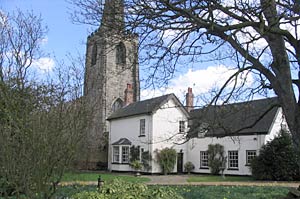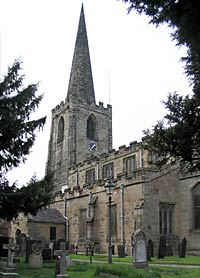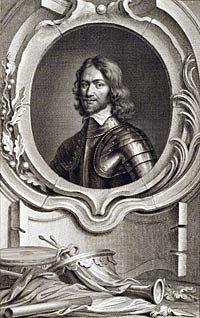< Previous | Contents | Next >
Famous Brothers
ATTENBOROUGH. Proud of its possessions as it lies between the busy road and the river, it leaves the stir of the world, with the closing of the railway crossing gates for the seclusion of charming houses and gardens, leafy lanes, and broad Trent meadows.

Ireton's house and Attenborough church (2006).
In the shadow of the church tower, its garden adjoining the churchyard, is a farmhouse which has still traces of the old home of the Iretons, and here were born two famous brothers, John who became Lord Mayor of London, and Henry who married Cromwell's daughter Bridget. Henry's baptism in 1611 and John's in 1615 are both in the register.
Henry studied law, and at the outbreak of the Civil War, when he was living here, offered his services to Parliament. He fought at Edgehill and Marston Moor, and was one of Cromwell's right-hand men. He signed the death-warrant of the King, died of plague, and was buried in the Abbey; and at the Restoration was taken from his grave, dragged to Tyburn, and hanged from sunrise to sunset. His brother John was thrown into prison and transported to the Scilly Islands.

Attenborough church (2004).
The church so well known to those two brothers, in the nave of which Cromwell stabled his horses, is beautiful without and within; and, though its atmosphere is eloquent with the story of the years, it has been so cared for that it might have been built yesterday. It is a charming blending of stone and woodwork old and new, with lovely medieval windows.
The 500-year-old tower has a lofty spire and traceried windows. The rebuilt porch shelters a 14th century doorway and three gravestones carved in the 12th, 13th, and 15th centuries. Its great treasure is the door itself, with three iron hinges of simple scrolls, which may have belonged to the doorway now blocked in the north wall. If so it must be one of the oldest doors in the land, for the doorway comes from the age when the Norman style was passing.
The lofty nave has a 15th century clerestory with a window over the chancel arch, and two 700-year-old arcades which each lost half an arch when the tower was built. The hoods of the pointed arches have bold carving ending in fine corbels of heads and a grotesque. The striking carving of the capitals crowning the round pillars is a feature of the church, those on the south side being a little later and more grotesque than the others. Twelve extraordinary figures on the three south capitals, one at every corner, are all grotesque except for a bishop's mitred head, most of them heads with wings or limbs and no bodies. In company with the bishop is a pig-faced grotesque, a hooded man, and a jester with a wide grin on his contorted face. Others are a pig with cloven feet and a creature with a tiny head, features of a bird, a round body with wings, and huge hands or claws.
The east window, which has at each side an old bracket carved with a winged figure, sheds a golden light with its picture of two angels and the three Marys looking up at Our Lord risen from the tomb. Lovely glass in the north aisle shows Joseph in red and gold with a lantern and staff, and Mary in red and blue with the Holy Child. The peace window has St Nicholas, St George, and an angel with a crown, and three small scenes from the front. There are fragments of old glass.
Beautiful oak lines the chancel walls, adorns the organ, and makes the pulpit lovely with panels of intricate tracery. Four Jacobean panels, set in the splendid modern choir stalls, are carved with a mermaid, a merman with his tail in the mouth of a sea monster, and a dragon which seems to be charmed by a small figure blowing a horn. The old chancel screen has gone, but two splendid 15th century stall-ends over six feet high are by the priest's doorway. The nave and chancel have fine flat roofs, that of the nave keeping some of its old moulded beams. The massive altar-table is Elizabethan, the font is 600 years old, and the rood stairs and doorway are in the south aisle which is strengthened by two flying buttresses inside the church. Into this peaceful churchyard, which is like a shaded garden and has an ancient yew, strife has come, for a simple cross and rows of graves tell the story of a terrible day in the Great War when many lives were lost in a frightful explosion in the munition works at Chilwell. Here we get a fine view of the wooded bills of Clifton, Barton, and Gotham across the river, and of Brent's Hill, which the Ancient Britons knew.
Cromwell's Right-Hand Man

Henry Ireton by Jacobus Houbraken, published by John & Paul Knapton, after Samuel Cooper line engraving, published 1742 (1741) NPG D19476
© National Portrait Gallery, London.
HENRY IRETON, at the outbreak of the Civil War, was living quietly here on his estate. He had taken his Art Degree at Oxford and had studied law at Middle Temple without having been called to the Bar. He was made captain of the Commonwealth troop of horse raised by Nottingham, and fought with it under Essex at Edgehill.
He commanded the same force at Gainsborough, and from that time forward was closely associated with Cromwell, under whom he quickly distinguished himself as one of the officers of the New Model. During the battle of Naseby Ireton's left wing was ridden through by the terrific charge of Prince Rupert, but with his broken forces he went valiantly to the succour of a disorganised body of Roundhead infantry, when he had his horse killed under him and was himself run through the thigh and taken prisoner.
When Cromwell's courage and generalship restored the fortunes of the day and converted the Cavalier success into a rout, Ireton was still a prisoner and helpless. He told his captor that if he would carry him back to the Roundhead lines he should have his freedom.
The invalid was soon restored, resumed fighting, and played a major part in the negotiations which led to the surrender of Oxford. It was while fighting and parleying were going on there that Ireton was vouchsafed a brief remission from his military duties to marry Cromwell's daughter Bridget.
A sincere affection linked Cromwell and his son-in-law. "I write not to thy husband," runs a letter from Oliver to Bridget; "partly to avoid trouble, for one line of mine begets many of his, which I doubt makes him sit up too late." The younger man played an important part in the years which followed. He would have saved Charles if the king could have been relied upon; it is plain that Ireton could and would have preserved the dynasty but for Charles's failure to respond to generous treatment.
But when all else failed Ireton became one of the most energetic members of the court which condemned the king. Afterwards he accompanied Cromwell to Ireland, and on the return of Oliver to England remained there as Lord Deputy. In this office, says Ludlow, who was his colleague, he conducted himself with great ability, and with unbounded devotion to the public service.
When Parliament voted him lands and a life pension of £2000 a year he firmly refused both. His patriotism was untinged by motives of personal gain. The nation, he said, had many just debts which it should pay rather than offer land and money to him who had desire for neither.
He worked himself almost to death, and plague did the rest. He died at Limerick in 1651. His body was brought to London, where it lay in state at Somerset House, and was afterwards interred in Henry the Seventh's chapel with a magnificent monument, such as his friends believed Ireton would have utterly disapproved. Nine years later his remains were dragged from the tomb, drawn on a hurdle to Tyburn, hanged on a gibbet and afterwards buried at its foot, where the feet of those who pass the Marble Arch trample over his dust.
